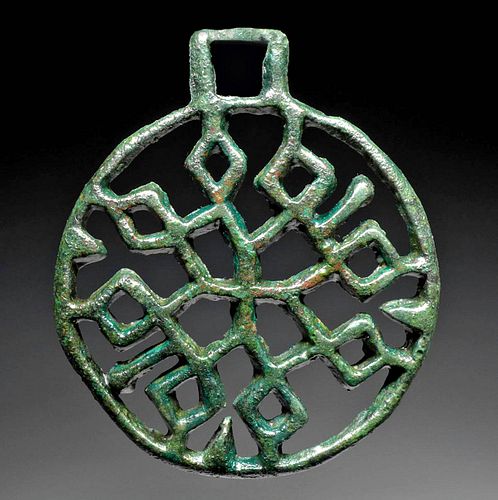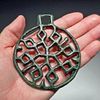Rare Scythian Saka Openwork Bronze Medallion Pendant
About Seller
686 S Taylor Ave, Ste 106
Louisville, CO 80027
United States
Selling antiquities, ancient and ethnographic art online since 1993, Artemis Gallery specializes in Classical Antiquities (Egyptian, Greek, Roman, Near Eastern), Asian, Pre-Columbian, African / Tribal / Oceanographic art. Our extensive inventory includes pottery, stone, metal, wood, glass and textil...Read more
Two ways to bid:
- Leave a max absentee bid and the platform will bid on your behalf up to your maximum bid during the live auction.
- Bid live during the auction and your bids will be submitted real-time to the auctioneer.
Bid Increments
| Price | Bid Increment |
|---|---|
| $0 | $25 |
| $300 | $50 |
| $1,000 | $100 |
| $2,000 | $250 |
| $5,000 | $500 |
| $10,000 | $1,000 |
| $20,000 | $2,500 |
| $50,000 | $5,000 |
| $100,000 | $10,000 |
| $200,000 | $20,000 |
About Auction
Nov 10, 2022
Museum-worthy examples of classical antiquities (Egyptian, Greek, Roman, Near Eastern), Viking, Far East / Asian, Pre-Columbian, African / Tribal, Oceanic, Native American, Spanish Colonial, Nautical, Fossils, Ancient Jewelry, Fine / Visual Arts, so much more! Artemis Fine Arts info@artemisfinearts.com
- Lot Description
Central Asia, Steppe region, Scythian Empire, Saka / Scythian culture, ca. 8th to 2nd century CE. This is a spectacular cast bronze large open work medallion pendant made by ancient nomadic peoples. It features an intact geometric design that could have possibly been a clan badge - an overt display of association with a certain tribe, similar to a family crest. The suspension bail shows it was hung from a strap, perhaps over the forelock of the horse, or along the sides or breast of the horse, since the large proportions would be impractical to wear by a person on a regular basis. The Saka and Scythians were famous for elaborate decorations of their horses, the royal and wealthy warriors adorned their prized mounts with objects such as this incredible medallion! In ancient Saka life, the horse was central to everything in life, and their horses were often decorated as elaborately as their riders, with the higher noble, wealthier class individuals displaying extravagant embellishments. Size: 4.2" L x 3.6" Diameter (10.7 cm x 9.1 cm)
The Saka were a group of nomadic Iranian peoples who historically inhabited the northern and eastern Eurasian Steppe and the Tarim Basin. Though closely related, the Sakas different from the Scythians of the Pontic Steppe and the Massagetae of the Aral Sea region, though they all form part of the wider Scythian cultures. Like the Scythians, the Sakas were ultimately derived from the earlier Andronovo culture. The Sakas were a group of Iranian peoples who spoke a language belonging to the Iranian branch of the Indo-European languages. Historical records and scientific studies date the Saka as early as the 8th century BCE. In the Achaemenid-era, ancient Persian inscriptions found at Persepolis, dated to the reign of Darius I (reign 522 to 486 BCE), record the Saka as having lived just beyond the borders of Sogdia. An inscription dated to the reign of Xerxes I (reign 486 to 465 BCE) has them associated with the Dahae people of Central Asia. In the 2nd century BCE, many Sakas were driven by the Yuezhi from the steppe into Sogdia and Bactria and then to the northwest of the Indian subcontinent, where they were known as the Indo-Scythians. Other Sakas invaded the Parthian Empire, eventually settling in Sistan, while others may have migrated to the Dian Kingdom in Yunnan, China. In the Tarim Basin and Taklamakan Desert region of Northwest China, they settled in Khotan, Yarkand, Kashgar and other places, which were at various times vassals to greater powers, such as Han China and Tang China.
Provenance: ex-private New York, USA collection, formed in the 1960s
All items legal to buy/sell under U.S. Statute covering cultural patrimony Code 2600, CHAPTER 14, and are guaranteed to be as described or your money back.
A Certificate of Authenticity will accompany all winning bids.
We ship worldwide and handle all shipping in-house for your convenience.
#175617Complete without restoration and great patina.Condition
- Shipping Info
-
Artemis Gallery will no longer be able to offer in-house shipping for most international orders, as well as all oversized orders, including most paintings. These items are clearly marked in the listing as “3rd Party Shipping Required” in the listing. We have a list of recommended third party shippers to assist you in shipping to and from, and would be happy to assist you in working with them. We require a written authorization from the client to release property to any third party. You may fax a Shipping Release Form to 303-828-3235 or email your authorization to kristen@artemisgallery.com. Please note the all property must be removed from our premises within seven (7) business days following the last day of the auction.
-
- Buyer's Premium



 EUR
EUR CAD
CAD AUD
AUD GBP
GBP MXN
MXN HKD
HKD CNY
CNY MYR
MYR SEK
SEK SGD
SGD CHF
CHF THB
THB














